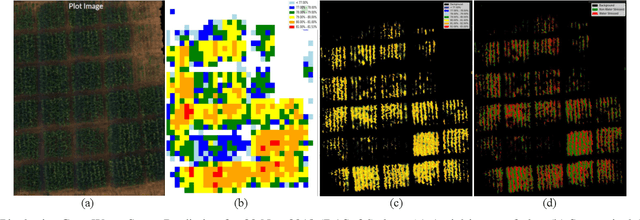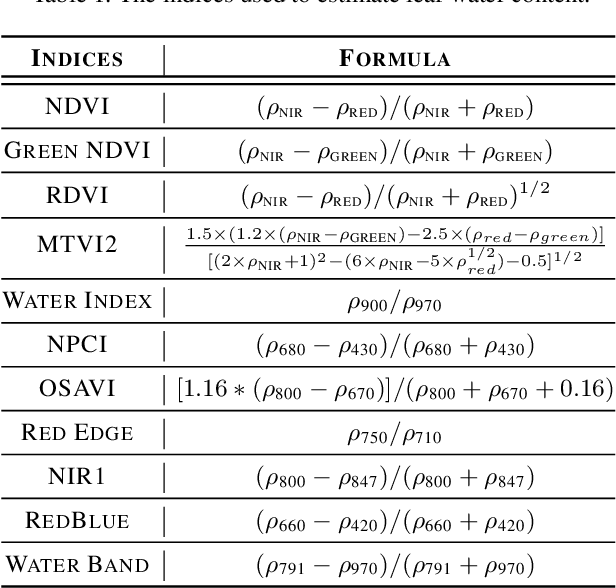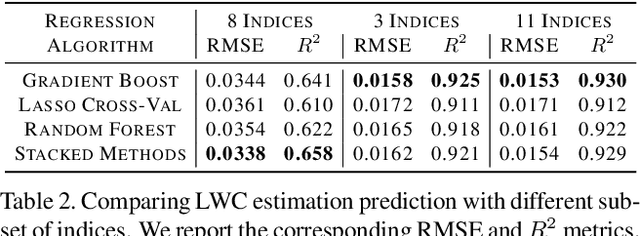Rahul Raj
Estimating Leaf Water Content using Remotely Sensed Hyperspectral Data
Sep 06, 2021


Abstract:Plant water stress may occur due to the limited availability of water to the roots/soil or due to increased transpiration. These factors adversely affect plant physiology and photosynthetic ability to the extent that it has been shown to have inhibitory effects in both growth and yield [18]. Early identification of plant water stress status enables suitable corrective measures to be applied to obtain the expected crop yield. Further, improving crop yield through precision agriculture methods is a key component of climate policy and the UN sustainable development goals [1]. Leaf water content (LWC) is a measure that can be used to estimate water content and identify stressed plants. LWC during the early crop growth stages is an important indicator of plant productivity and yield. The effect of water stress can be instantaneous [15], affecting gaseous exchange or long-term, significantly reducing [9, 18, 22]. It is thus necessary to identify potential plant water stress during the early stages of growth [15] to introduce corrective irrigation and alleviate stress. LWC is also useful for identifying plant genotypes that are tolerant to water stress and salinity by measuring the stability of LWC even under artificially induced water stress [18, 25]. Such experiments generally employ destructive procedures to obtain the LWC, which is time-consuming and labor intensive. Accordingly, this research has developed a non-destructive method to estimate LWC from UAV-based hyperspectral data.
Comparative performance analysis of the ResNet backbones of Mask RCNN to segment the signs of COVID-19 in chest CT scans
Aug 21, 2020



Abstract:COVID-19 has been detrimental in terms of the number of fatalities and rising number of critical patients across the world. According to the UNDP (United National Development Programme) Socio-Economic programme, aimed at the COVID-19 crisis, the pandemic is far more than a health crisis: it is affecting societies and economies at their core. There has been greater developments recently in the chest X-ray-based imaging technique as part of the COVID-19 diagnosis especially using Convolution Neural Networks (CNN) for recognising and classifying images. However, given the limitation of supervised labelled imaging data, the classification and predictive risk modelling of medical diagnosis tend to compromise. This paper aims to identify and monitor the effects of COVID-19 on the human lungs by employing Deep Neural Networks on axial CT (Chest Computed Tomography) scan of lungs. We have adopted Mask RCNN, with ResNet50 and ResNet101 as its backbone, to segment the regions, affected by COVID-19 coronavirus. Using the regions of human lungs, where symptoms have manifested, the model classifies condition of the patient as either "Mild" or "Alarming". Moreover, the model is deployed on the Google Cloud Platform (GCP) to simulate the online usage of the model for performance evaluation and accuracy improvement. The ResNet101 backbone model produces an F1 score of 0.85 and faster prediction scores with an average time of 9.04 seconds per inference.
 Add to Chrome
Add to Chrome Add to Firefox
Add to Firefox Add to Edge
Add to Edge